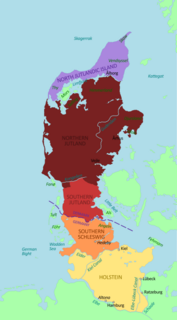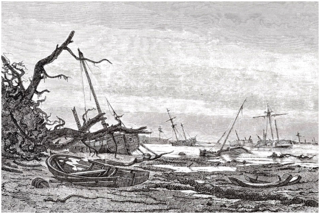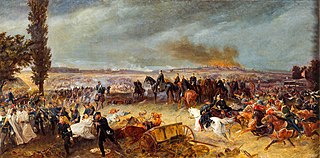 W
WThe history of Schleswig-Holstein consists of the corpus of facts since the pre-history times until the modern establishing of the Schleswig-Holstein state.
 W
WThe 1872 Baltic Sea flood, often referred to as a storm flood, ravaged the Baltic Sea coast from Denmark to Pomerania, also affecting Sweden, during the night between 12–13 November 1872 and was, until then, the worst storm surge in the Baltic. The highest recorded peak water level was about 3.3 m above sea level (NN).
 W
WThe Austro-Prussian War or Seven Weeks' War was fought in 1866 between the Austrian Empire and the Kingdom of Prussia, with each also being aided by various allies within the German Confederation. Prussia had also allied with the Kingdom of Italy, linking this conflict to the Third Independence War of Italian unification. The Austro-Prussian War was part of the wider rivalry between Austria and Prussia, and resulted in Prussian dominance over the German states.
 W
WBeltring Hundred was a mediaeval hundred located in the southern part of North Frisia in the Danish region of Southern Schleswig, part of the Frisian Uthlande. It encompassed the northern part of the island of Strand, which sank in 1634 during the Burchardi flood. Some of the land of Beltring Hundred survived the flood, however, and became the Hallig of Nordstrandischmoor as well as the site of the modern municipality of Ockholm. Beltring Hundred was one of the so-called Five Hundreds or Strand Hundreds on the island, the others being Edoms Hundred, Pellworm Hundred, Southern Goes Hundred, and Lundenberg Hundred.
 W
WThe Danevirke or Danework is a system of Danish fortifications in Schleswig-Holstein, Germany. This historically important linear defensive earthwork across the neck of the Cimbrian peninsula was initiated by the Danes in the Nordic Iron Age about AD 650. It was later expanded multiple times during Denmark's Viking Age and High Middle Ages. The Danevirke was last used for military purposes in 1864 during the Second War of Schleswig.
 W
WThe terms Danish March and March of Schleswig are used to refer to a territory in modern-day Schleswig-Holstein north of the Eider and south of the Danevirke. It was established in the early Middle Ages as a March of the Frankish Empire to defend against the Danes. The term "Danish March" is a modern designation not found in mediaeval sources. According to the Royal Frankish Annals the Danish King led his troops "into the March" in 828. In the 852 Yearbook of Fulda there is mention of a "Guardian of the Danish Border".
 W
WEdoms Hundred was a mediaeval hundred located in the southern part of North Frisia in the Danish region of Southern Schleswig, part of the Frisian Uthlande. It encompassed the eastern part of the island of Strand, which sank in 1634 during the Burchardi flood, including some of the land which now comprises the peninsula of Nordstrand. Edoms Hundred bordered the other so-called Five Hundreds or Strand Hundreds on the island: Beltring Hundred to the north, Pellworm Hundred to the west, Southern Goes Hundred to the east, and Lundenberg Hundred to the south.
 W
WThe Gau Schleswig-Holstein was formed on 26 February 1925. It was an administrative division of Nazi Germany from 1933 to 1945 in the Prussian Province of Schleswig-Holstein, parts of the Free State of Oldenburg and, from 1 April 1937, the Free City of Lübeck. Before that, from 1925 to 1933, it was the regional subdivision of the Nazi Party in that area.
 W
WGottorf Castle is a castle and estate in the city of Schleswig, Schleswig-Holstein, Germany. It is one of the most important secular buildings in Schleswig-Holstein, and has been rebuilt and expanded several times in its over eight hundred years of history, changing from a medieval castle to a Renaissance fortress to a Baroque castle.
 W
WHedeby was an important Danish Viking Age trading settlement near the southern end of the Jutland Peninsula, now in the Schleswig-Flensburg district of Schleswig-Holstein, Germany. It is the most important archaeological site in Schleswig-Holstein. Around 965, chronicler Abraham ben Jacob visited Hedeby and described it as, "a very large city at the very end of the world's ocean."
 W
WThe Hedeby Viking Museum is a museum near the site of Hedeby, a former medieval city in Schleswig-Holstein, Germany focusing on the Viking Age history of the region. While the region is now in modern Germany, it was once the oldest city in Denmark until it was ceded in 1864. The museum features reconstructions of various Viking Age dwellings, ships, and houses numerous artifacts discovered during the ongoing archaeological research of the area.
 W
WDie Heimat was the title of a monthly journal that was published from 1891 to 2002 on the subject of the natural history and regional culture of Schleswig-Holstein and neighbouring regions. Since 2003, the journal has been called Natur- und Landeskunde: Zeitschrift für Schleswig-Holstein, Hamburg und Mecklenburg.
 W
WHolstein is the region between the rivers Elbe and Eider. It is the southern half of Schleswig-Holstein, the northernmost state of Germany.
 W
WKiel Castle in Kiel in the north German state of Schleswig-Holstein was one of the secondary residences of the Gottorf dukes. The castle exhibited a very varied architectural history and in the more recent architectural period became one of the most important secular buildings in Schleswig-Holstein. The castle burned down during the Second World War and its ruins were largely carried away and replaced by a new building.
 W
WLundenberg Hundred was a mediaeval hundred located in the southern part of North Frisia in the Danish region of Southern Schleswig, part of the Frisian Uthlande. Lundenberg Hundred was one of the so-called Five Hundreds or Strand Hundreds on the island, the others being Edoms Hundred, Beltring Hundred, Southern Goes Hundred, and Pellworm Hundred. It encompassed the southeastern part of the former island of Strand, between what are now the peninsulae of Nordstrand and Eiderstedt.
 W
WThe Nordic Bronze Age is a period of Scandinavian prehistory from c. 1700–500 BC.
 W
WIn the duchies of Schleswig and Holstein, the term "partitioned-off duke" was used to denote a series of dukes whose territories were not recognized by the estates of the realm.
 W
WPellworm Hundred was a mediaeval hundred located in the southern part of North Frisia in the Danish region of Southern Schleswig, part of the Frisian Uthlande. It encompassed the western part of the island of Strand, which sank in 1634 during the Burchardi flood. Pellworm Hundred was one of the so-called Five Hundreds or Strand Hundreds on the island, the others being Edoms Hundred, Beltring Hundred, Southern Goes Hundred, and Lundenberg Hundred. The land that remained of the hundred after the flood is now largely geographically part of the modern island of Pellworm in the German state of Schleswig-Holstein.
 W
WRungholt was a settlement in Nordfriesland, in what was then the Danish Duchy of Schleswig. The area is today located in Germany. Rungholt reportedly sank beneath the waves of the North Sea when a storm tide hit the coast on 15 or 16 January 1362.
 W
WThe Duchy of Saxony was originally the area settled by the Saxons in the late Early Middle Ages, when they were subdued by Charlemagne during the Saxon Wars from 772 and incorporated into the Carolingian Empire (Francia) by 804. Upon the 843 Treaty of Verdun, Saxony was one of the five German stem duchies of East Francia; Duke Henry the Fowler was elected German king in 919.
 W
WScanian law is the oldest Danish provincial law and one of the first Nordic provincial laws to be written down. It was used in the geographic region of Danish Skåneland, which at the time included Scania, Halland, Blekinge and the island of Bornholm. It was also used for a short period on the island of Zealand. According to some scholars, the Scanian Law was first set down between 1202 and 1216, around the same time it was translated into Latin by the Danish Archbishop Anders Sunesøn.
 W
WThe Schleswig Regiment of Foot is a Royal Danish Army infantry regiment. On 1 January 2001 it was merged, together with the Queen's Life Regiment, into the Prince's Life Regiment. In 2018 it was announced that the regiment would be reestablished on 1 January 2019, as a light infantry battalion.
 W
WThe Duchy of Schleswig was a duchy in Southern Jutland (Sønderjylland) covering the area between about 60 km north and 70 km south of the current border between Germany and Denmark. The territory has been divided between the two countries since 1920, with Northern Schleswig in Denmark and Southern Schleswig in Germany. The region is also called Sleswick in English.
 W
WSkamlingsbanken is a large hill located in Vejstrup Parish, Jutland, Denmark, between Kolding and Christiansfeld. With a peak rising to 113 metres (371 ft) above sea level, it is the highest point in Southern Jutland.
 W
WThe Talking Gravestones of Amrum, also known as the Story-telling Gravestones, are historic artifacts on the German island of Amrum, one of the North Frisian Islands off the west coast of the Jutland Peninsula. They stand in a legally protected section of the St. Clemens Church cemetery in the village of Nebel. The gravestones, totaling 152, are inscribed with sometimes detailed accounts of the occupations, life histories, social rank and families of the deceased. The best-known gravestone is for Hark Olufs, an early 18th-century seafarer and folk hero. Similar objects can be found at the neighbouring island Föhr.
 W
WThe Talking Gravestones of Föhr, also known as the Story-telling Gravestones, are historic artifacts on the German island of Föhr. They can be found in the cemeteries of St. Laurentii church in Süderende (54.7163°N 8.4352°E), St. Johannes church in Nieblum (54.6934°N 8.4911°E), and St. Nikolai church in Boldixum (54.6958°N 8.5504°E), which is now a district of Wyk auf Föhr. Similar objects are known from the neighbour island of Amrum. All such headstones made until 1870 are designated cultural heritage monuments. Their inscriptions tell the biographies of the deceased including their private and professional lives, extraordinary events, and honorary appointments. With 265 monuments, the St. Johannis cemetery has the largest inventory of historical gravestones in Nordfriesland district. The best-known tombstone is the one of Matthias Petersen who was a very successful whaling captain and was therefore dubbed "Lucky Matthew". The only ornamental decoration on this stone is a circular relief depicting the goddess of fortune upon a swimming whale in the style of a coat of arms. It features the only inscription completely in Latin language in the cemetery of Süderende, which relates that Petersen who died in 1706 caught 373 whales during his lifetime.